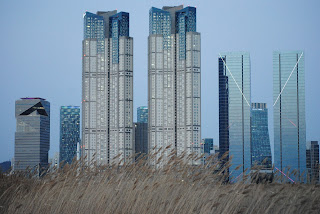The
day I
arrived at the Korea Polar Research Institute (KOPRI) it felt cold and windy outside;
as if I had spent more than twelve hours rather travelling north than east.
Except for the February weather the location of the Korean Polar Research Institute is anything else than polar. Songdo is one of the very new districts of South
Korea’s third biggest city Incheon, west of its capital Seoul. It is a special
place not only because of the many skyscrapers that mark the Songdo
skyline. It is also exceptional because only until recently there were tidelands where KOPRI is located today.
The land reclamation project started in the early 2000s. Since then about six square kilometers of Incheon's former marshy coasts have been filled up to build a sustainable and smart city. Songdo International Business District was developed to help internationalize Korea's economy by attracting global companies through its vicinity to the airport (20 minutes) and central location within Asia. At the same time, Songdo was designed 'around the people who live and work here', the Gale International real estate company announces on its website. Planning of what may be a city of future has been inspired by the great metropolitan areas of the world. Thus, green and open areas are mixed with multi-story office buildings for about 300,000 workers and homes for up to 65,000 residents.
 |
| The Songdo skyline |
KOPRI is located west of Songdo downtown, within an area called the Smart Valley. In 2013, the institute moved into the new buildings where about 300 people work today. And the institute is still growing, as constructions sites west of the completed buildings may tell. A common second floor connects the yet four separate buildings that are designed with blue and white glass fronts.
 |
| The Korean Polar Research Institute in Incheon, South Korea |
The entrance hall displays what Korean polar science is about: KOPRI not only maintains two field stations in Antarctica and one in the Arctic but also runs the Korean research icebreaker ARAON. Since 2009, RV ARAON is sailing both the Arctic and the Southern Ocean in order to carry out multidisciplinary scientific research in the polar regions.
 |
| Polar exhibition in the entrance area of KOPRI |
Enjoying the stunning sunset from the accessible roof of the KOPRI guest house with the Songdo downtown skyline somewhere in the back I can still feel the Arctic-like February wind. One of the concepts of making Songdo a smart city was to have both work and life within short walking distance. The guest house is thus in convenient door-to-door distance to the institute. But the KOPRI porter's office also borrows bikes. Because once in a while a polar scientist may want to escape from the perfectly planned working space and just enjoy what is the undesigned nature. (lbp)
  |
| Views from top of the guest house |
Keine Kommentare:
Kommentar veröffentlichen